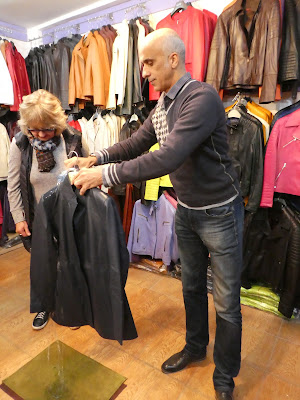Our local guide, Fatima.
We start by exploring the traditional Jewish quarter, called the mellah...
...where we visit a 17th century synagogue Ibn Danan Synagogue. Fatima is showing us where the Torah is kept.
Built in the 1600s by a prominent Moroccan Jewish family, the synagogue is among the last remaining buildings in this historic part of the city.Today, Ibn Danan is thought to be the only complete Moroccan synagogue in existence with wooden benches, oil lamps, and embroidered tapestries.
It was then time to wander through the heart of the medina where donkeys and mules are still the only means of transport.
We walked through the souks (markets) First, the food market...
We watched this lady make some kind of bread
Some goat heads? for sale.
Then the goods market...the streets were narrow with lots of twists and turns. We had to keep a close eye that everyone in our group was still with us.
And we heard "balak, balak" a lot. It roughly translates to "watch out or my donkey will run you over". They usually came by us so fast that it was hard to catch them in a photo.
Donkeys are the mode of transporting goods to merchants and they rule the alley.
When they came by, we squeezed against the nearest wall.
Sometimes we went through very narrow walkways in this maze of the medina.
We stopped by the Medrassa of Cherratin, a university founded in 1670.
and peeked inside the Al Qaraouin mosque. The mosque is considered Morocco’s holiest place, governing all Islamic festivals across the country.
Lunch at a restaurant in the medina was..
Tagine! A tagine is a cone-shaped cooking vessel traditionally used in Morocco. A meal cooked in the tagine is the typical meal we have for lunch or dinner.
On today's menu was chicken tagine with lemon. It was one of the best-tasting tagine meals we were served.
The most interesting place we stopped at in the medina was the tannery where leather is made.
The tannery guide passed out sprigs of mint to hold under our noses. The mint aroma did little to mask the pungent odor of leather and vats of dye. Can't imagine having to work for hours in the smell.Then, of course, we had the opportunity to see the leather goods store.
Some of the shops featured everything needed for a Moroccan wedding.
And one can also come here to buy a casket. Fatima is explaining that when buried, the head of the deceased is facing the holy city of Mecca.
Our last stop in the medina is at a shop that weaves material.
We watched a demonstration of the weaving.
Saw some finished product
Got a lesson in wrapping the head scarves...
and a group photo of everyone, all in scarves!
That evening we attended a home-hosted dinner with a local couple, Hussain and Nadia. We saw photos and learned all about their wedding. The bride wears 7 dresses in about 6 hours! They use a wedding planner to rent the dresses and jewelry, and are brought out in a white carriage! Just like we saw earlier today in the shops of the medina.
It was a wonderful evening visiting with this family. And Nadia's tagine was really good, too!
After breakfast the next day, we were off to tour two UNESCO World Heritage Sites, Volubilis and Meknes about an hour or so outside of Fez.
It was a pretty drive.
We passed lots of groves of olive trees.
Then all of a sudden, Mohammed asked the bus driver to stop. Alongside the road was an olive farmer working his harvest. Mohammed jumped off the bus and asked the farmer if he would please visit with our group of travelers. He agreed and Mohammed introduced us to Nourddin.
Nourddin explained that he was waiting for his olives to be picked up and sold.
Then all of a sudden Nourddin left and ran into his house across the road. He returned a few minutes later with a loaf of bread and a jar of olive oil.
He offered all of us a taste.
It was a great experience to meet Nourddin and learn a little about his life as an olive farmer.
It was then onward to Volubilis, where we met our local guide, Abdelhay. Volubilis is one of the most well-preserved Roman cities in North Africa.
He guided us around and explained the Roman impact on northern Morocco during the 3rd century BC.
The city was once an affluent capital of about 20,000 people who exported olives, olive oil and wheat to Rome.We explored the well-preserved mosaics of the villas.
We then traveled a short distance to Meknes a city founded in the 9th century.
Meknes was once the home of the Moroccan sultanate. There are massive gates around this walled city.
We stopped by the granaries that were built for the 17th century sultan Moulay Ismail. The granaries could store huge amounts of grain.
It is a massive structure that once held 12,000 horses.
Tried a panorama to capture the immense size but the photo doesn't do justice.
To end our tour we stopped by the Bab Mansur gate. Meknes has over 20 gates lining its protective walls. Bab Mansur gate is considered the most beautiful.
It was built at the beginning of the 18th century. The marble columns were taken from the Roman ruins of Volubilis where we visited earlier today.
The huge door inside the gate.
Next to the gate is the public square of Meknes, which was filled with vendors.
Dinner that night was at the riad. We certainly did not lack delicious food.
Pastilla (chicken pie) was my favorite meal.
The next morning we leave this beautiful riad and the town Fez and start the Sahara desert part of this trip.
To continue reading, scroll down and click on "Newer Post".






































































No comments:
Post a Comment